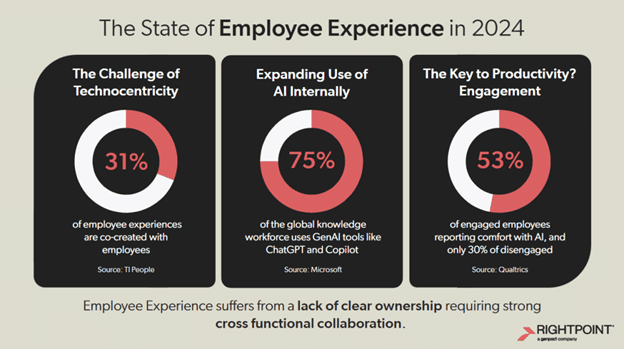Employee engagement is more than just a nice-to-have. In fact, Gallup’s State of the Global Workplace report estimates that low employee engagement costs the global economy $8.9 trillion USD annually, or 9% of the global GDP.
However, low engagement incurs costs beyond what can be measured in dollars, with employees themselves taking a hit. According to Gallup research, employees in companies with disengaging management practices are nearly 60% more likely than those in well-managed environments to experience stress.
Technology uniquely influences employee experience and engagement depending on the workplace, people, tasks and other conditions. A recent article in Harvard Business Review put it this way: “Technology and workplace tools are, for all intents and purposes, the new workplace.”
Neither the pace of technology nor the thirst for a better work experience show signs of slowing down. So, what can HR leaders expect in the coming year when it comes to how technology influences employee engagement and experience? Human Resource Executive asked experts for their predictions for 2025 and beyond. Here’s what they had to say.
Digital noise and workplace stress
There is growing concern among experts that digital tools—meant to streamline work and enhance collaboration—are contributing to workplace stress and reducing productivity, based on the results of a recent study. In 2024, the employee experience platform Unily surveyed 500 employees from large organizations in the U.S. and U.K. It was discovered that 59% of employees say digital tools contribute to their workplace stress. This twist indicates that while these workplace tech platforms are critical, they can overwhelm employees if not managed properly.

Chris Ciauri, CEO at Unily, points out that over three-fourths of survey respondents find notifications from workplace digital tools distracting. However, nearly the same amount say digital tools are a critical part of helping them to feel connected at work.
“The biggest takeaway for me is that when tools that are supposed to make work easier for employees start to have the opposite effect, [the] approach to employee experience must evolve,” says Ciauri.
Integration and simplification of tools
Employees increasingly seek a consolidated digital experience where multiple tools are integrated to reduce noise and improve efficiency. A more unified tech stack, possibly enhanced by AI, can help employees prioritize important tasks and reduce distractions, according to the experts.
The Unily report found that digital notifications disrupt the focus of one in three workers every 15 minutes or less. However, Ciauri says, the research supports that nearly 60% of employees also believe that tech—AI in particular—has the potential to help them manage digital noise and prioritize what is important.
The survey found that 83% of employees responded that adopting a “super app”—one that consolidates multiple tools into a single interface—would make their lives easier, says Ciauri. This sentiment was strongly supported across all worker types, from managers to non-desk-based workers.
Support for managers
Ciauri says that one of the unexpected research findings was that managers appear to be suffering the most from digital noise. Seventy-one percent of managers report that digital tools add to their workplace stress, compared to 59% of all respondents. “We know that managers contribute significantly to team engagement levels, and many managers are raising warning flags in today’s workplace,” says Ciauri.
If managers are shouldering the burden of digital noise by acting as a buffer between employees and workplace distractions, organizations must carefully consider how to protect and support them in an environment overwhelmed by digital excess, says Ciauri.

The experts say that people, particularly strong leaders, are still a key part of a positive workplace experience. Tom Keuten, senior vice president and Microsoft alliance lead at experience company Rightpoint, says that employees still want and need great mentors and leaders. He predicts that leaders will amplify human-to-human connections that make employees feel part of something bigger than themselves. Keuten suggests that as technological opportunities increase, the importance of human connection in realizing those opportunities grows even more.
Human-centered technology
It seems that the role of HR technology is evolving to better align with the need to drive human engagement. Based on the submissions to the 2024 Top HR Tech Products competition, there is a growing focus on enhancing the employee experience, according to the judging panel. Rightpoint’s Keuten puts it this way: “Great HR technology has the opportunity to make an employee feel like the whole work experience has been created for them to contribute, learn and grow.”
As digital tools become more integrated into work processes, balancing technology with genuine human interactions will be crucial, particularly as new people enter the workforce. A 2024 NSHSS survey of 10,000 participants, primarily high school students from diverse backgrounds, found that nearly half of Gen Z consider clear communication skills the most important quality in an employer. This indicates that future workers will prefer technology that enhances, rather than replaces, human connection in the workplace.
AI and employee experience
A 2024 study from cloud communication platform RingCentral predicts that the next chapter in the AI era is all about employee and customer experiences. Over 60% of respondents—based on an international group of nearly 700 business leaders—are using AI for employee interactions. However, the implementation of AI needs to be carefully managed to ensure it supports rather than hinders employee engagement.

This movement touches on how employees in the HR department will engage with the wider workforce. Kyle Berry, principal at business management firm Sendero Consulting, says the evolution of artificial intelligence is reshaping human capital management.
AI-powered features can enhance employee experience by allowing workers to optimize schedules and find HR-related answers independently, says Berry. This accessibility is easy and efficient for employees while also freeing up resources so the people team can focus on more complex tasks.
The evolution of the employee experience (EX) role
Experts predict the employee experience professional is expected to become more strategic, focusing on aligning technology, human resources and organizational goals. “Whether by intentional design or simply by arrival over time, organizational design often represents a structure that does not directly align to employee experience,” says Keuten. He predicts this will change as EX professionals focus on aligning functions and minimizing the impact of organizational silos and competing incentives on employees.
Keuten says the EX professional’s job is maturing, with a heavy slate of expected responsibilities. To be successful in the future, he predicts these workers must collaborate with HR to prioritize key moments in the employee lifecycle, use technology to support adoption, align goals with leadership and work directly with managers and employees to improve processes.
With the employee-employer relationship continuously evolving, EX professionals will have to continue to educate themselves, says Keuten. They will need to develop strong partnerships with advisors outside their organizations and be able to clearly articulate the value of the work they’re doing in business terms. “It’s going to be a wonderful space to work in over the next decade,” he adds. “Lots of opportunities to improve the experience of work for those around them.”
Changing employee expectations
Berry anticipates that as workplace technology and systems continue to advance, the expectations of employees will increasingly center around simplicity and accessibility. Employers that successfully meet these expectations will have a competitive advantage in attracting and retaining talent, he says.
“The technology in this space is moving very quickly, which is creating opportunities and risks at the same time,” says Keuten. The emerging mindset will understand the connection between technology and human connections, where each supports and is dependent on the other, according to Keuten. He says that as business leaders consider HR technology, they must contemplate every system an employee touches that will impact their experience between the time they are recruited and the time they leave the organization.
Data-driven engagement
The use of data analytics and AI in HR tech is seen as crucial for improving employee engagement. This is reflected in the most recent releases from the vendor community. “This year, the best HR tech innovators aren’t just talking about how advanced their new technology is,” says HR Technology Conference Chair Steve Boese. “They are proving use cases that enable HR leaders to make more informed, data-driven decisions.”
These tools can provide valuable insights into employee behavior and sentiment, allowing organizations to proactively address issues and enhance the overall work experience. “While a well-functioning HCM may be taken for granted by employees, an insufficient one is something employees will notice and can significantly disrupt daily operations,” says Berry.
Additionally, AI can deliver valuable analytics and insights into employee trends and sentiment. Berry points out that by analyzing data such as performance metrics and feedback, managers can better understand employee experiences and identify potential issues early. This proactive approach enables organizations to address concerns promptly, ultimately enhancing overall employee satisfaction.
Balancing technology and engagement initiatives
Rightpoint’s Jesse Murray, senior vice president of employee experience, says the historical challenge for employees has not been a lack of tools, but rather, far too many tools and tools that do not work together. “The more recent AI-driven expansion of collaboration tool options and capabilities has exacerbated that issue, creating user confusion, lost productivity and lower engagement,” says Murray.

With so many elements in the tech stack, employees should have at least some autonomy and flexibility to choose tools that suit their preferences. Ciauri predicts that workers who feel their organization isn’t supporting them by listening to their needs will eventually struggle with engagement.
“In the coming years, I anticipate HCM systems will evolve to prioritize the employee experience more than ever before,” says Berry. He finds that when organizations gather employee sentiment on culture, they can proactively shape a workplace environment that resonates with employees.
Using tech for employee listening facilitates culture improvements and provides insights to address areas that influence talent attraction and retention. “By leveraging these insights from employee feedback, organizations can tailor their overall strategies to foster a supportive and inclusive workplace culture,” says Berry.

Tips for HR leaders
Rightpoint’s Murray encourages employers to take the following steps to optimize HR technology for employee engagement.
- Understand the employees who are going to be using the platform and then design it to be personalized to their roles and feel like the organization’s culture, values and brand identity.
- Integrate the platform with existing tools and systems that employees use regularly, and ensure compatibility and interoperability across devices and platforms.
- Create a clear and consistent communication plan that informs employees about the benefits, features and expectations of the new platform. Solicit employee feedback and input on how to improve it.
- Establish a network of champions or ambassadors who can promote the adoption and usage of the new platform and provide peer-to-peer guidance and assistance to other employees. These employees are incentivized to reach out to their peer group and ensure the tools are being used productively for their roles.
- Leverage gamification, rewards, recognition or incentives to motivate and encourage employees to explore and engage with the new platform and celebrate their achievements and contributions. This is especially beneficial when company leaders participate.
The post Low employee engagement costs billions; how to improve in 2025 appeared first on HR Executive.